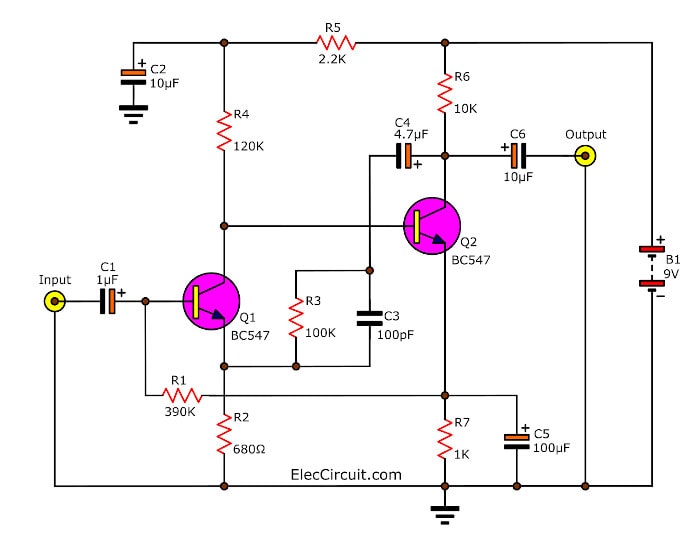What Is Transistor Bc547

What is transistor bc547
BC547 is a Bipolar Junction Transistor, abbreviated as BJT. It is an NPN transistor. It has three terminals named as: Emitter.
Why it is called BC547 transistor?
BC547 is a name registered under the Pro-Electron numbering system. The Pro Electron system is the European type designation and registration system for active components, such as electronic tubes and cathode ray tubes, semiconductors, liquid crystal displays, sensor devices, etc.
What is transistor is used for?
A transistor can act as a switch or gate for electronic signals, opening and closing an electronic gate many times per second. It ensures the circuit is on if the current is flowing and switched off if it isn't. Transistors are used in complex switching circuits that comprise all modern telecommunications systems.
Is BC547 an amplifier?
BC547 Double Transistor Audio Amplifier.
What are 2 types of transistors?
Transistors typically fall into two main types depending on their construction. These two types are bipolar junction transistors (BJT) and Field Effect Transistors (FET).
What are the three types of a transistor?
Transistors are broadly divided into three types: bipolar transistors (bipolar junction transistors: BJTs), field-effect transistors (FETs), and insulated-gate bipolar transistors (IGBTs).
What are the 3 function of transistors?
transistor, semiconductor device for amplifying, controlling, and generating electrical signals.
What is transistor and how it works?
A transistor is an electronic component that is used in circuits to either amplify or switch electrical signals or power, allowing it to be used in a wide array of electronic devices. A transistor consists of two PN diodes connected back to back. It has three terminals namely emitter, base and collector.
What is the full name of transistor?
The words trans mean transfer property and istor mean resistance property offered to the junctions. In other words, it is a switching device which regulates and amplify the electrical signal likes voltage or current. The transistor consists two PN diode connected back to back.
What are the two main uses of transistors?
The core use of transistors includes switching applications or both amplification and switching.
What devices use a transistor?
Transistors are also found in pacemakers, hearing aids, cameras, calculators, and watches. Most of these devices draw their power from tiny batteries. Most spacecraft also rely on microchips, and thus transistors. The transistor is truly the "nerve cell" of the information age.
What is transistor in simple words?
Definition of transistor 1 : a solid-state electronic device that is used to control the flow of electricity in electronic equipment and usually consists of a small block of a semiconductor (such as germanium) with at least three electrodes. 2 : a transistorized radio.
What are the 3 types of amplifiers?
- Amplifier is an electronic device which amplifies the input power of the signal.
- The types of the amplifier are: 2.1 Voltage amplifier: The voltage amplifier increase the input voltage. 2.2 Current amplifier: Current amplifier increase the input current. 2.3 Power amplifier: A power amplifier increase the input power.
What is the difference between transistor and amplifier?
One of the key characteristics of a transistor is that it can be used as an amplifier. Transistors can act as amplifiers while they are functioning in the active region or when it is correctly biased. The need for transistor as an amplifier arises when we want to increase or amplify the input signal.
What are the 3 types of amplifiers using a transistor?
Three of the most fundamental transistor amplifiers are: common emitter, common collector and common base.
Why is called transistor?
The word transistor is a combination of transfer and resistance. This is because it transfers the resistance from one end of the device to the other end or we can say, transfer of resistance. Hence, the name transistor. Transistors have very high input resistance and very low output resistance.
What is NPN and PNP transistor?
PNP switches ON by a low signal whereas NPN switches ON by a high signal. In PNP transistors, the P represents the polarity of the emitter terminal and N represents the polarity of the base terminal. In NPN, N represents the negatively charged coating of the material whereas P represents the positively charged layer.
What is the most popular transistor?
Metal–oxide–semiconductor FET (MOSFET) The MOSFET is by far the most common transistor, and the basic building block of most modern electronics. The MOSFET accounts for 99.9% of all transistors in the world.
How do you test a transistor?
Hook the positive lead from the multimeter to the to the BASE (B) of the transistor. Hook the negative meter lead to the EMITTER (E) of the transistor. For an good NPN transistor, the meter should show a voltage drop between 0.45V and 0.9V. If you are testing PNP transistor, you should see “OL” (Over Limit).
What is P type transistor?
The determination of transmitting or disconnecting depends on the type of transistor: A P-type transistor (indicated by a circle on the gate line) transmits when gate is 0, while an N-type transistor (which has no such circle) transmits when gate is 1. The behavior is summarized by the following tables. P-type. gate.












Post a Comment for "What Is Transistor Bc547"